“Why do I need a puppy socialisation plan?” you may be thinking.
Well, if you take away just one point from this guide then make it this one:
The extent of those problems will vary by breed, sex, and the genetic make-up of your particular puppy.
But make no mistake. If you fail to adequately socialise your puppy you will be creating problems for your dog (and yourself) at a later date.
And for the poor dog, this may mean being left at a shelter or even being put to sleep.
Puppy Socialisation Defined
Before we begin our puppy socialisation plan in earnest, let’s take a moment to think about what we mean by the term socialisation.
After all, if we don’t know what the term means how will we be able to plan how to socialise a puppy?!
The online Collins Dictionary defines it as:
“When people, especially children, are socialised, they are made to behave in a way which is acceptable in their culture or society.”
Collins Dictionary
So what does this mean in the context of puppies?
Socialisation means exposing your puppy to different experiences now so that as an adult dog he will know how to act appropriately when facing those same experiences.
OK, let’s get started with our Puppy Socialisation Plan.
1 The Importance of Socialisation
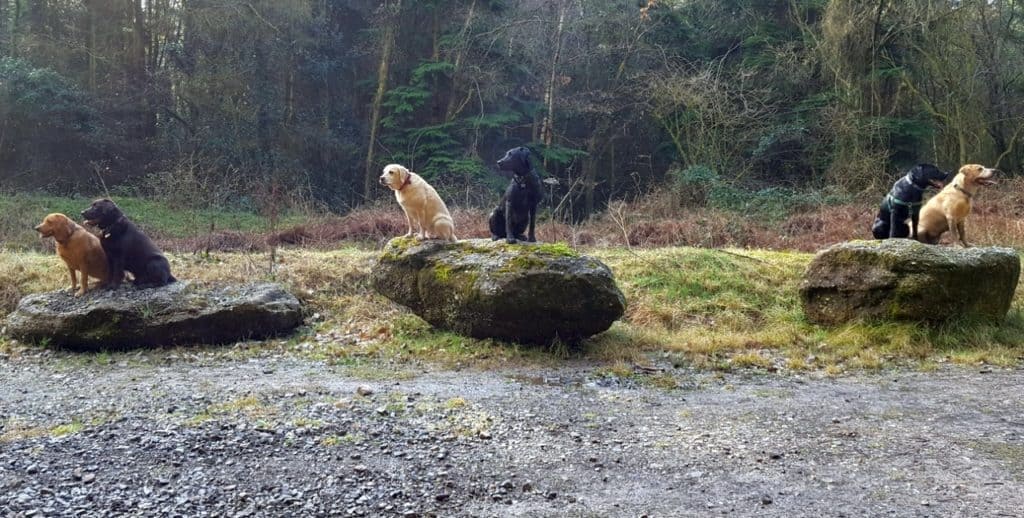
Wouldn’t it be nice to have an adult dog that is happy in the company of other dogs, even groups of dogs? (That’s my dog Harvey on the far right)
Or to be able to take your dog with you to a pub or cafe and have him happily sit or lie with you without being afraid (and demonstrating his fear by barking at the other people there).
Or even simply to enjoy a walk without having to worry about confrontations with other dogs.
You might assume that this will happen by itself without any effort from you. Unfortunately, that is unlikely to be the case.
1.1 Socialisation and Vaccination
Many people are, understandably, a little wary about socialising their puppies before their puppies have had all of their vaccinations.
However, this needs to be given some context.
In relation to the importance of socialisation compared to the transmission of disease, especially in relation to initial vaccinations, Dr R. K. Anderson, a highly regarded veterinarian and animal behaviourist said that based upon 10 years of data in the United States:
“… the risk of a dog dying because of infection with distemper or parvo disease is far less than the much higher risk of a dog dying (from euthanasia) because of a behaviour problem.”
Dr R K Anderson
Our vet, Ian Clarke of Ambleside Vets, has also been good enough to let me have some of his thoughts on the importance of socialisation.
“Early socialisation is very important for the future welfare of your pet, allowing them a much greater chance of learning good social skills with humans and other dogs. This means that they will learn to interact positively rather than tending toward fear aggression.
For the dog owner the same is true; it’s great to see your dog off the lead enjoying play with other dogs, meeting new people. Conversely, it’s a real pain if your dog has to be permanently on the lead or muzzled, or if you are always worrying when the next dog or human might appear at home or on walks.
However, the worst scenario is that your dog becomes such a sociopath, threatening to bite and biting anyone at any time that they become as dangerous as a loaded firearm.
Early socialisation, between the age of approximately 8 and 14 weeks, when lots of behaviour patterns are established helps avoid this.
A final thought, in my home area the risk of euthanasia for behaviour problems far outweighs the risk of diseases that we vaccinate against.”
Ian Clarke MAVet.MB of Ambleside Vets
Furthermore, socialisation with other dogs is just one aspect of the process.
There is plenty of other socialisation that you can be undertaking (see later in the article for a detailed Puppy Socialisation Plan). Especially with people.
Now, I’m not saying that you should have a cavalier attitude to the risk of the various canine diseases. Just don’t let it prevent you from starting the process of socialising your puppy.
There are some simple guidelines that you can follow to minimise the risk of infection:
- Don’t allow your puppy to mix with dogs of unknown vaccination status.
- Don’t take your puppy to parks, or other public spaces, where other dogs will have fouled.
- If in doubt, remember that it is perfectly ok to carry your puppy in order to avoid contact with potentially contaminated environments.
1.2 Socialisation and Training
When you think about Collecting a New Puppy you probably have all sorts of ideas about what you are going to do with your four-legged friend.
For many people, their priorities are:
- Obedience training (sit, down, come etc)
- House training
- Socialisation (infrequently and only after fully vaccinated)
In my view that is the exact opposite of what your priorities should be.
By a long way.
Seriously, it’s not even close!
Why?
Contrary to popular opinion, you can teach an old dog new tricks. That is, you can teach obedience to a dog at any age.
You can teach a dog the Sit cue at 8 weeks old or at 8 years old.
However, the key period for socialisation is when your puppy is very young (and the period doesn’t last very long).
In other words, socialisation is very time-sensitive.
That doesn’t mean that it can’t also be enjoyable. You just need to devote some time to this activity for the benefit of your puppy.
If you already have a local dog trainer in mind for your puppy then speak with them about the importance of socialisation. Check whether they organise puppy parties / puppy classes too.
We use Lisa Jackson, of Lisa Jackson’s Dog Training, and she has been kind enough to comment as follows:
I think it is really important to conduct careful and thorough socialisation and habituation with young pups, making it fun and engaging.
Lisa Jackson of Lisa Jackson’s Dog Training
As Lisa says, make it fun and engaging. If you do, your puppy will pick things up much more quickly.
2 The Benefits of Socialisation
Actually, all of the benefits (plural) derive from one key benefit (singular).
That is, it will increase the probability of having an adult dog that is comfortable with all sorts of people, animals, and environments.
On the other hand, failure to socialise a puppy is likely to produce an adult dog whose behaviour problems are unpleasant to live with – both for him and for you.
Research has shown that a failure to socialise a puppy can result in adult dogs that exhibit classic ‘problem’ behaviours – aggression and fearfulness.
They are more likely to be aggressive towards both people and other dogs.
Not because they are nasty or vicious but through fear and anxiety resulting from the lack of socialisation as a puppy.
Just think of the places that you would like to be able to take your dog but will either not be able to or will find it massively stressful.
It’s bad enough to miss out on the enjoyment of taking your dog with you to a pub or cafe, to do some shopping, take a walk in the park, or any number of everyday things.
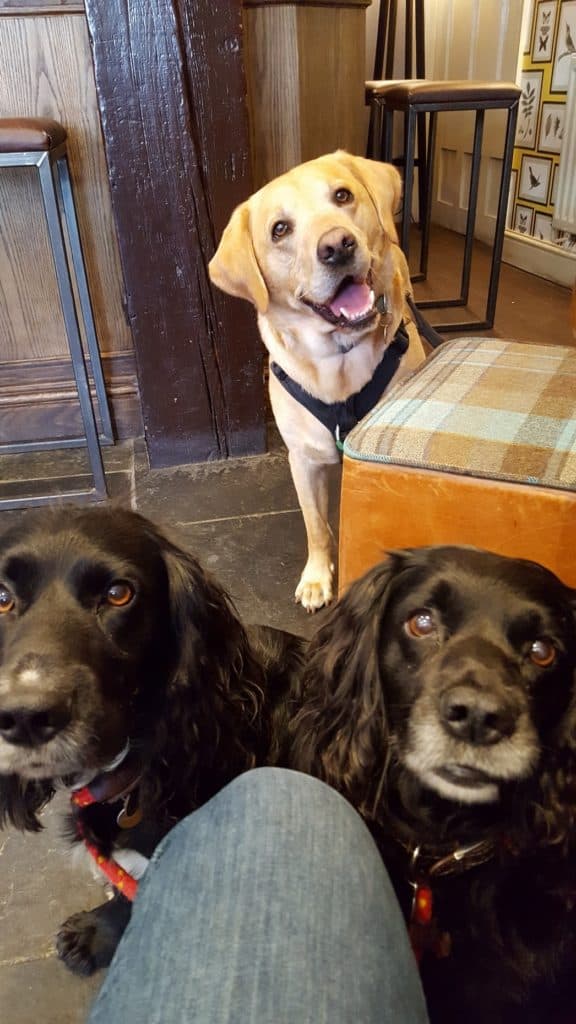
Or simply wanting to go to a training class but being unable to because, surprise, there are other dogs and people there.
But just think of what a nightmare it would be if your dog is scared of going to the vet.
Think of it from the perspective of a poorly socialised dog:
- Other dogs of various breeds and sizes
- Other animals that he isn’t familiar with
- Strange people … including somebody that wants to handle him, look in his eyes, lift his ears up, and to stick things up him or in him!
No wonder he is scared. Especially if you, his protector, don’t seem to be doing anything about it.
And how is his fear likely to manifest itself?
He might tuck his tail between his legs, cower, and shake. All the while with his eyes so wide that the whites show.
And that is the absolute best that you can hope for.
What you might get is a dog that decides to warn these various sources of fear that he is not happy by barking, growling, snarling, or some combination of these.
And if the warnings are ignored he may feel the need to move things to the next level with either:
- an air bite (I’m not messing about – I’m seriously unhappy about this situation!), or
- an actual bite (Right! That’s it! I’m going to give you a damn good biting!)
3 The Socialisation Period
Research has shown that there are a number of key periods in a puppy’s social development.
These are:
- Primary part 1 – Neonatal. Birth – 2 weeks
- Primary part 2 – Transitional. 2 – 3 weeks
- Socialisation. 3 – 12/14 weeks
- Juvenile. 12/14 weeks – maturity
- Adulthood.
Primary
This first period runs from birth to around 3 weeks of age.
Puppies do not yet have fully developed sensory awareness and are very much dependent upon their mother.
Until their sight and hearing begin to develop at the end of the period they primarily rely upon their sense of touch for moving around.
Studies have shown that gentle handling of a puppy every day during this period results in a calmer puppy at 8 weeks of age.

Check with the breeder of your puppy to see what their approach is to socialisation while the puppy is still being cared for by them.
Socialisation
This is it! This is the key period. This is why we need a Puppy Socialisation Plan.
Of course, your puppy’s genetic make-up will play a part in the way that it develops (some dogs are just naturally more relaxed, or more stressed, than others).
You can’t (unless you are some mad scientist type!) change your puppy’s genetics.
What you can do is to make full use of this key period to help your puppy develop as well as he possibly can.
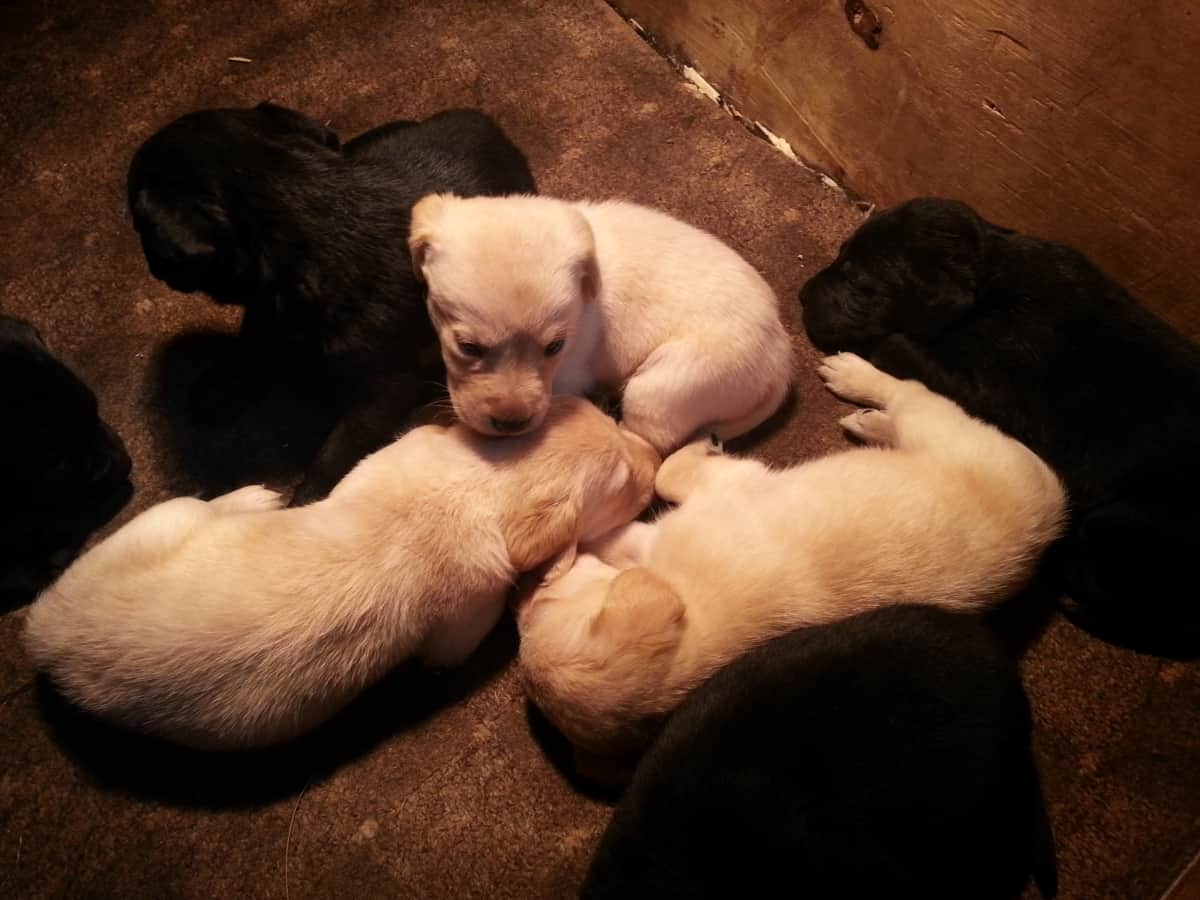
Up until around 8 weeks of age, the puppy should still be with its mother and littermates.
From around 5 weeks old the fear response begins to develop in puppies. The breeder should continue to handle the puppy during this time and, ideally, introduce new people to them too. Exposure to everyday sights and sounds would also be beneficial.
New owners typically collect their new puppy at around 8 weeks old. That’s when your socialisation responsibility begins. We’ll cover what you should be doing shortly.
Juvenile and Adulthood
Although research indicates that the Socialisation Period is the best time for socialisation to take place it doesn’t mean that it should stop at the end of that period.
You can, and should, continue to socialise your dog throughout his life. Just as adult humans can learn to overcome fears in later life so, too, can adult dogs.
4 How to Socialise a Puppy
When I was around 10-years-old some school friends and I used to play a ball game during breaks.
This consisted of throwing a tennis ball onto the sloped roof of a 3-story building and then competing to catch it when it rolled off the roof and fell to the ground.
Yes, we were that easily amused!
Now and then as the tennis ball rolled down the roof it would get stuck in the guttering. How annoying!
I would then climb up the drainpipe to where it met the guttering … swing across the guttering until I reached the ball … and then hang on with one hand while I picked out the tennis ball !!!
Well, roll forward a few years and I doubt that the drainpipe or guttering would take the strain these days! But would I do it if I knew that they would take the weight?
Hell no !!!
I could break my stupid neck (or ‘just’ my legs if I was lucky).
So why was 10-year-old me happy to do it without a second thought?
Because I had no fear.
Kids are pretty fearless when it comes to doing new and potentially dangerous things. Life hasn’t yet taught them that this may have a negative impact on their wellbeing.
And so it is with puppies during the Socialisation Period.
So, the puppy will be happy with the subsequent encounter because he will recall that he has had a similar encounter previously and it ended well. The puppy fearlessness is effectively being ingrained for the areas covered in the socialisation process.
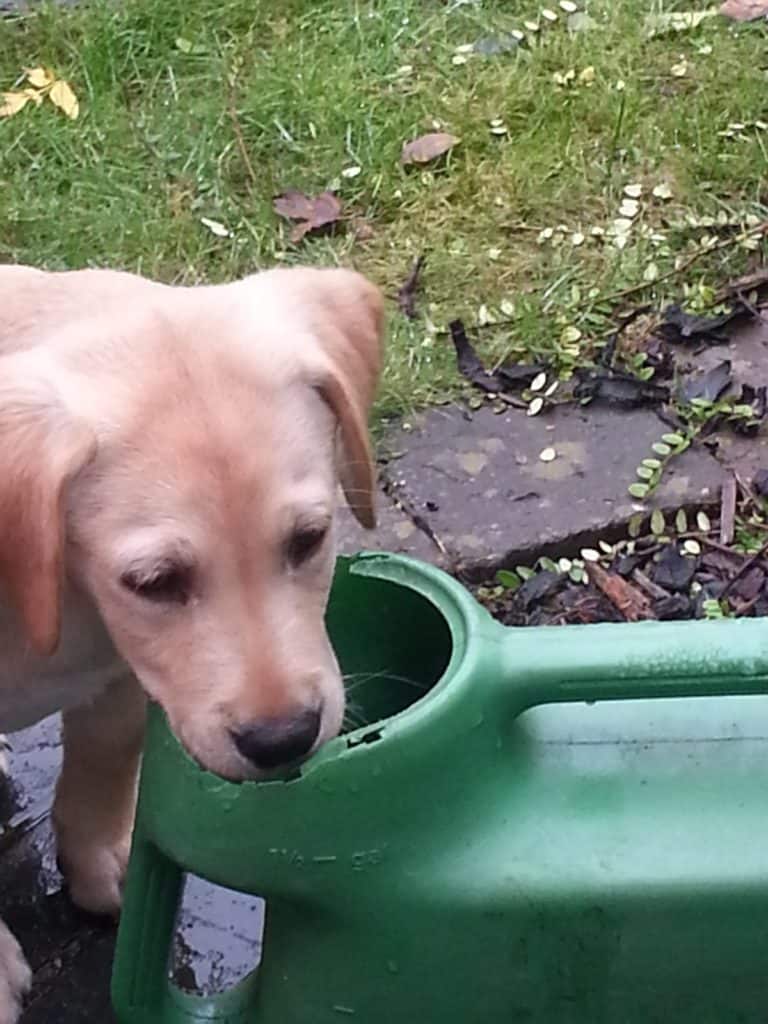
Classical Conditioning
This is the key concept for our socialisation process.
For more detail see the Positive Dog Training post.
Whenever the desired stimulus occurs we reward our puppy (typically with food or play). This helps our puppy to build a positive association with the stimulus.
For example, let’s say that we want to socialise our puppy in relation to meeting shop assistants (for those establishments where dogs are permitted).
Ideally, enlist the help of an assistant that you know in a local shop (or just have a word with one – most are happy to help if they aren’t too busy) to make it easier to control the situation.
Slowly approach the shop assistant and then put your puppy on the ground. Be guided by your puppy – if he is hesitant then wait until he is ready to move forward.
It isn’t necessary for all encounters to be ‘toe to toe’. If your puppy is wary then it’s ok to keep some distance from the stimulus in question. Just being close is still a valuable experience.
When you are happy with your puppy’s response you should immediately reward him. Better yet, have the shop assistant reward him. Remember we want to create that positive association.
As far as your puppy is now concerned, meeting a shop assistant is a good thing. A very good thing, as it may well result in a reward of some sort.
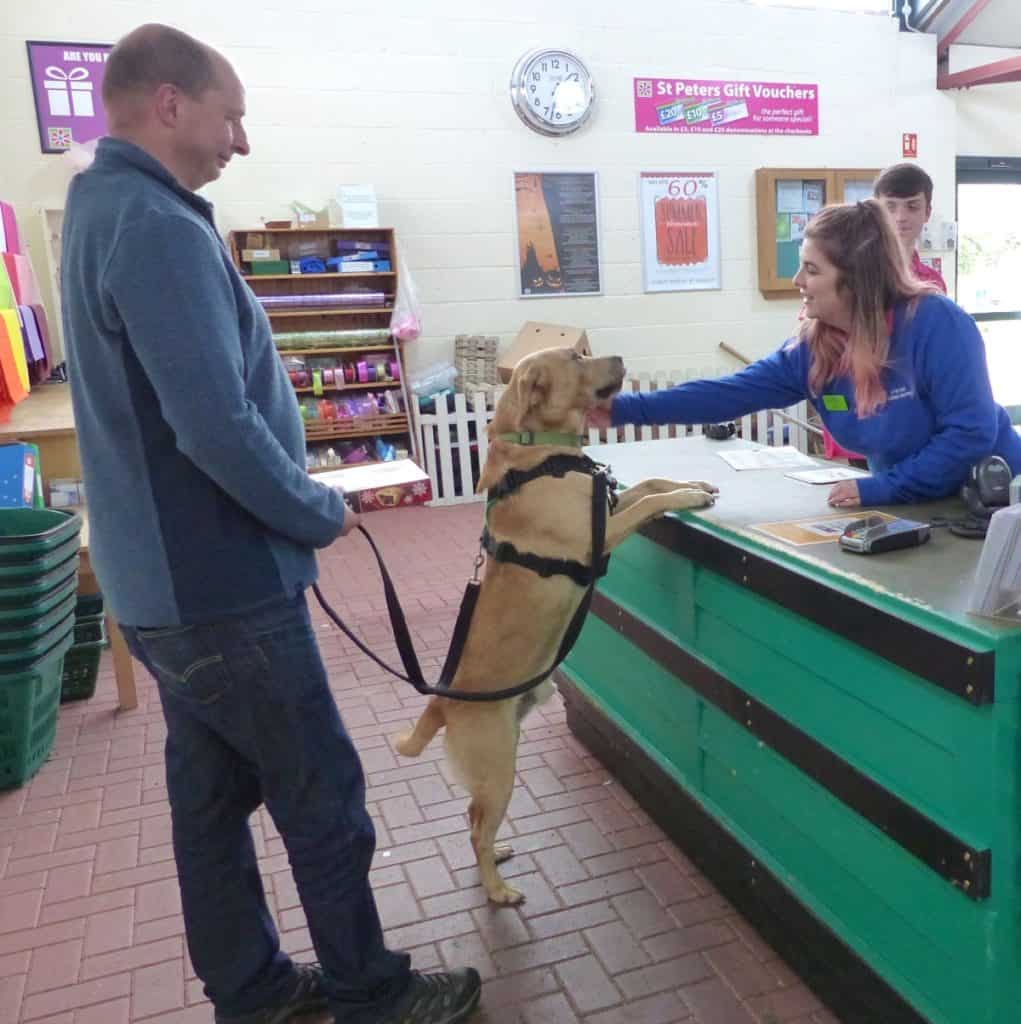
The Fear Factor
Your puppy will generally be pretty confident at this age and nearly fearless.
There may, however, be something that does frighten him. You are his protector and you need to be alert to this possibility.
Signs to look out for are:
- Cowering, especially with tail between legs
- Licking lips
- Yawning
- Excessive panting
- Ears back
- Eyes showing lots of white (the ‘Holy Crap what was that?’ look)
- Heightened alertness
It is better to remove your puppy from the situation and revisit it another day, perhaps after successful experiences in other areas, than to try to force the puppy to face its fears.
Be Careful What You Wish For!
When we first got our dog, Harvey, I looked into the process of how to socialise a puppy. I remember reading that the simplest of things can become problematic later in a dog’s life if they don’t have early positive encounters.
One particular area of concern cited was that of vacuum cleaners! Some dogs apparently become fearful of the noise and run and hide whenever one is used.
Right, I thought, this should be simple enough to crack.
I started just by bringing out the vacuum cleaner and leaving it alone, waiting for Harvey to approach it. Being the curious pup that he was this didn’t take long.
As soon as he approached it and sniffed it I immediately rewarded him with a treat.
Harv has always responded well to this type of training. It wasn’t long before he was approaching the vacuum cleaner again and looking for his reward.
The next step was to actually switch the vacuum cleaner on. From what I had read this was the real fear trigger so I did it gradually.
I started by having the maximum distance possible between Harv and the vacuum cleaner. Then I switched it on, waited for a couple of seconds, and switched it off again.
On the second switch-on Harv appeared to see what the noise was. Remember, our pups are curious and, largely, fearless at this stage. I switched the vacuum cleaner off and rewarded Harv again.
Had he shown any reluctance at this stage I would have stopped and revisited this task. But he didn’t. So I continued and within minutes he was happily right next to the vacuum cleaner while I streamed treats to him.
Fantastic. Well on the way to having a dog that isn’t scared of the vacuum cleaner.
And so on to the ‘Be careful what you wish for’ element …
We can’t now use the vacuum cleaner without Harv following us around and planting himself in the way until he gets a treat!
To be honest, it’s only a minor inconvenience, and quite amusing, but it just goes to show how powerful the classical conditioning process can be.
Pace yourself
There are a lot of areas to cover when it comes to socialising your puppy.
However, it is important not to overwhelm your puppy by asking too much of him too quickly. Gradually increase the number of positive encounters as your puppy gains confidence and as time passes.
5 What Needs to be Covered
The more positive experiences that your puppy has, before the socialisation period finishes, the better his socialisation will be.
So, what experiences do you need to prepare your puppy for?
Every experience that he will ever have, of course!
What’s that? You don’t have a [expletive] crystal ball?
Of course, you don’t.
That’s my point. It is hugely important that you undertake as much socialisation of your puppy as possible …
… but don’t expect to be able to cover every possible scenario. You’ll drive yourself mad.
Do the best that you can for your puppy and be happy with that.
It’s difficult sometimes to remember what areas have been covered and what still needs to be done. Having a plan or checklist will help you to monitor what you have done and what remains.
As well as planning for experiences, be alert to the possibility of opportunities arising naturally too.
For example, one day when we took Harvey to the pub (purely for socialisation purposes, of course!) we encountered somebody walking a goat!
I didn’t realise that goat walking using a lead was a thing, let alone taking them to the pub. But we made the most of the opportunity and ticked off another item on our socialisation list!
Areas to be covered
The various scenarios to be covered as part of your puppy’s socialisation can be broken down into a number of broad categories:
- People
- Handling
- Dogs
- Other animals
- Places and experiences
- Noises
- Surfaces and textures
- Other
I’ve expanded on these broad areas in the free downloadable Puppy Socialisation Plan that is available below.
Don’t be put off by the number of items listed. You’ll often find that you can tick off multiple items at once.
People
Meeting people, young and old, is the key element in your puppy socialisation plan as it is essential that your dog is comfortable in the presence of a variety of other people.
The more socialisation that you can do in this area the greater the prospect of having a friendly, approachable dog.
Whenever you go anywhere your first thought should be ‘Can I take my puppy with me?’
Most of the time the answer will be ‘Yes’ so look to make the most of these opportunities.
When you do meet people, don’t pass your puppy around as if you were playing some bizarre game of Pass The Parcel!
Ask them to crouch down so that they are less intimidating and then put your puppy down and let him move forward on his own terms.
As always, watch your puppy for any signs that he is becoming overwhelmed. If he is, calmly remove him from the situation.
Animals

There is no reason why most dogs and cats can’t get along. Many do so quite happily. Do be aware though that some dog breeds have a high prey drive and so may find this difficult.
A puppy’s exuberance can be a bit much for some cats and they may quickly put him in his place. A painful initial encounter would be a setback for socialisation.
Therefore, ensure that you control the situation. Have the puppy or cat in a crate so that physical interaction is, initially, limited. Or have the puppy on a collar and lead for the same reason.
Once there have been a few safe encounters like this you can remove the physical barriers. Watch the situation carefully and step in if necessary.
Keep the first such session fairly brief and reward a good outcome (for puppy and cat!).
Transport
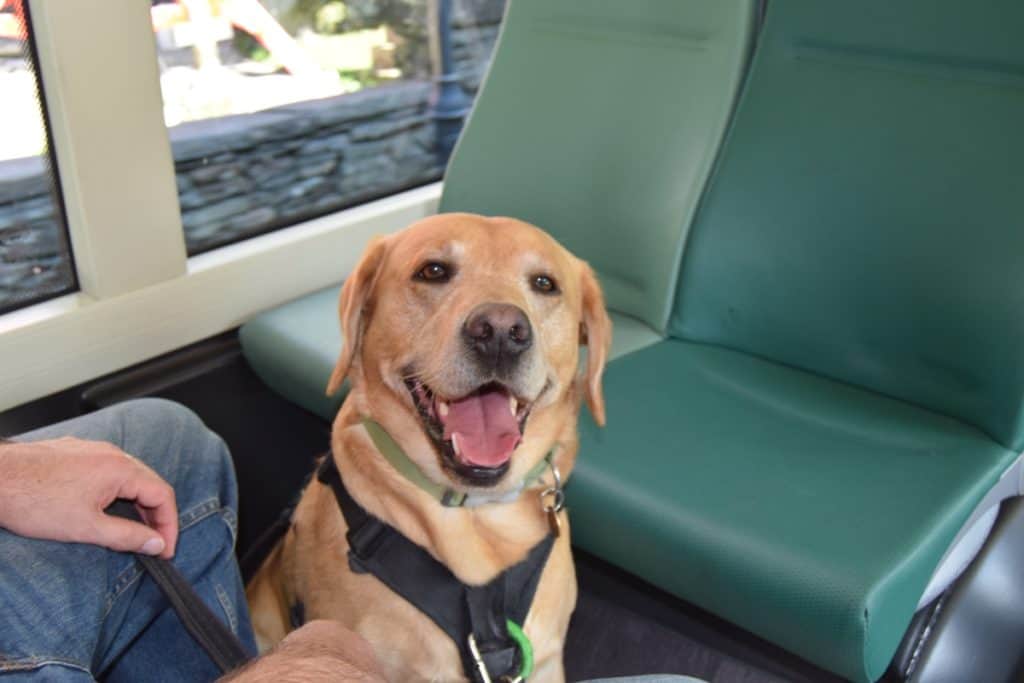
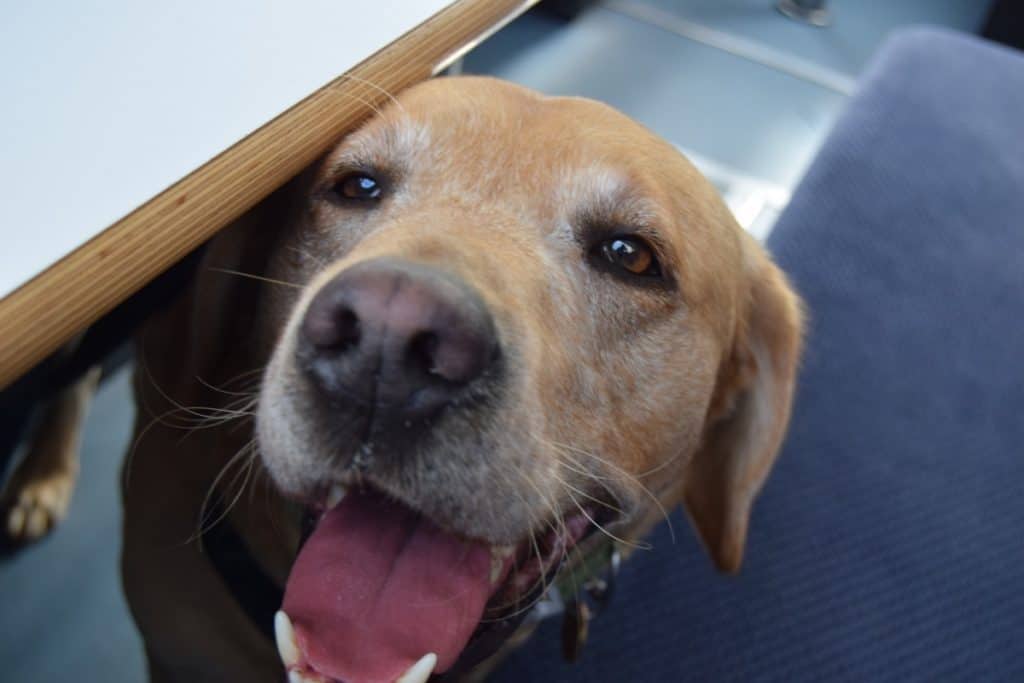
Surfaces and textures
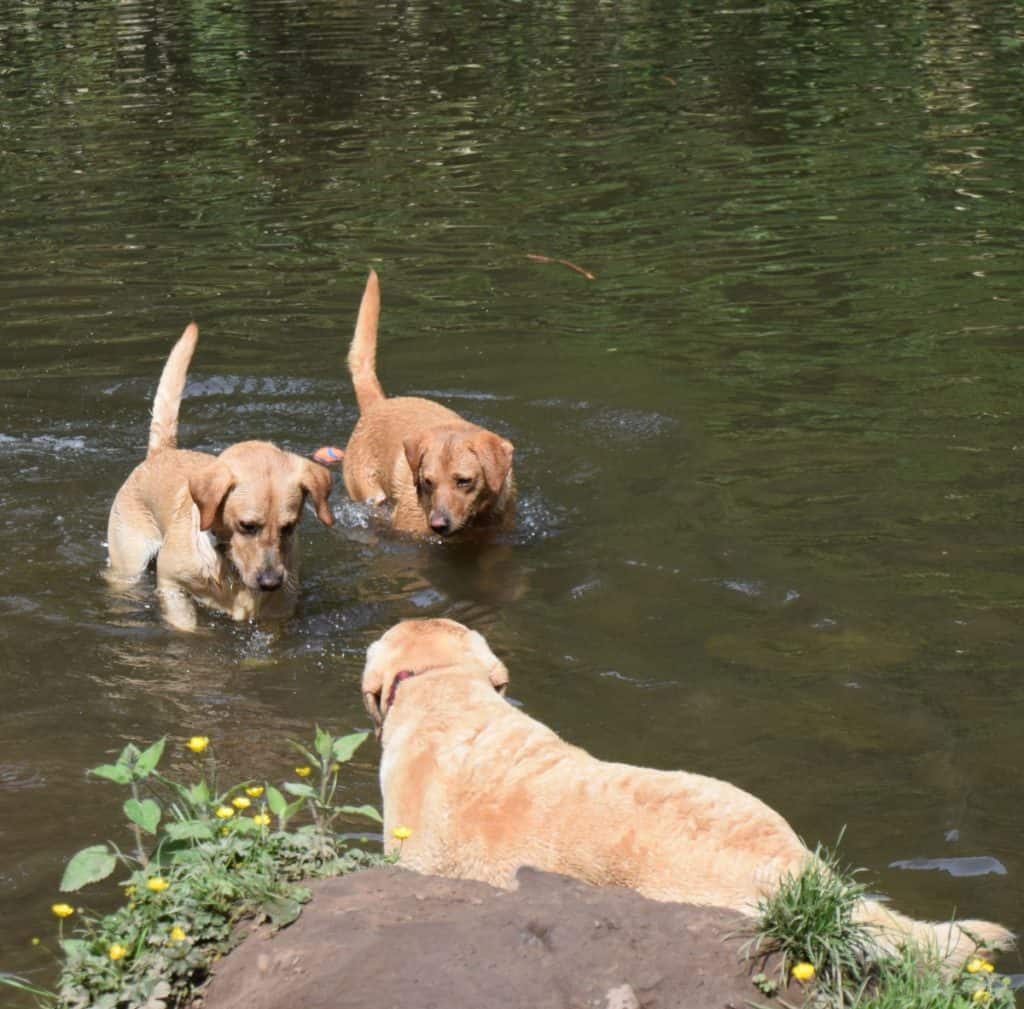
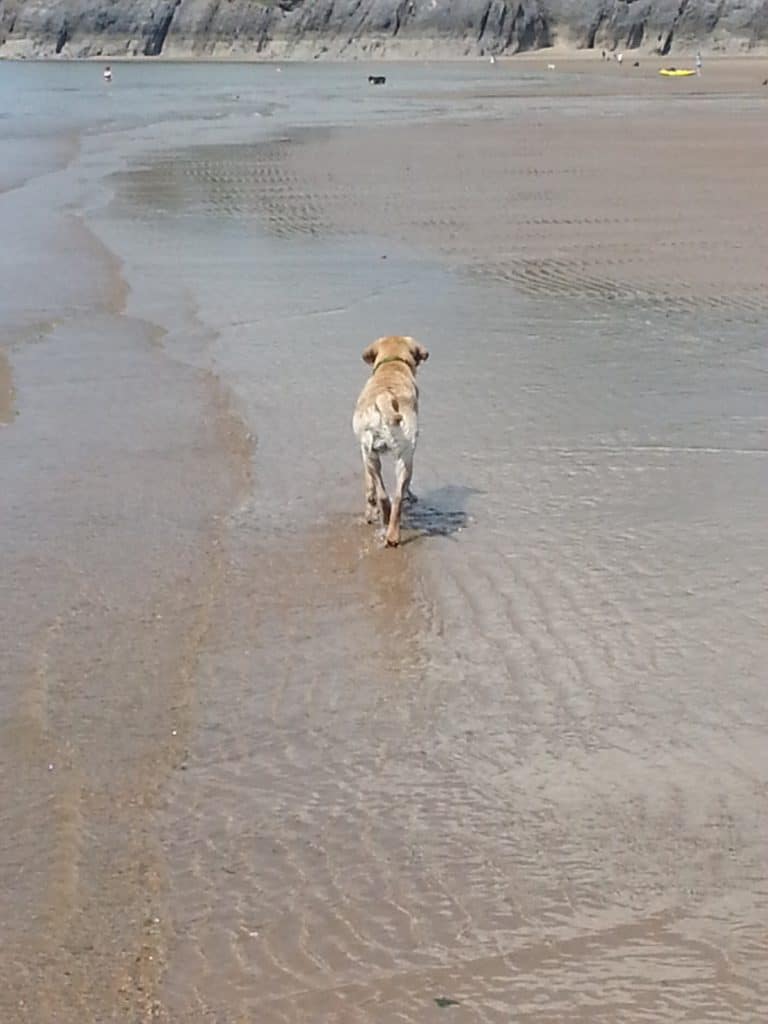


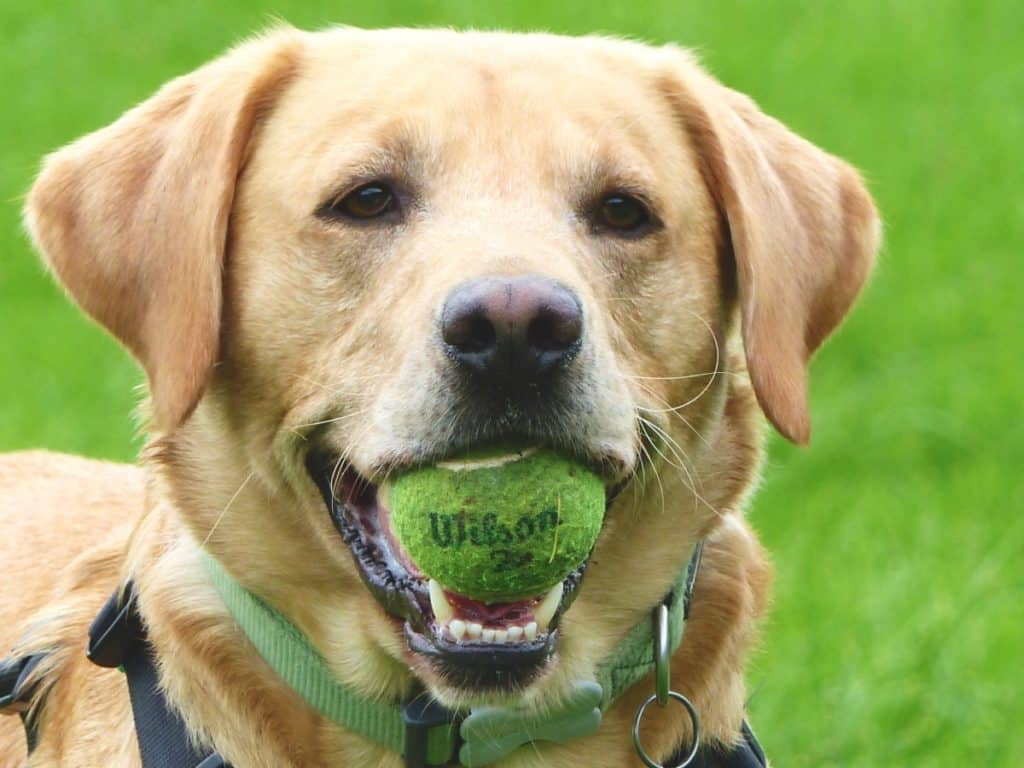
Other
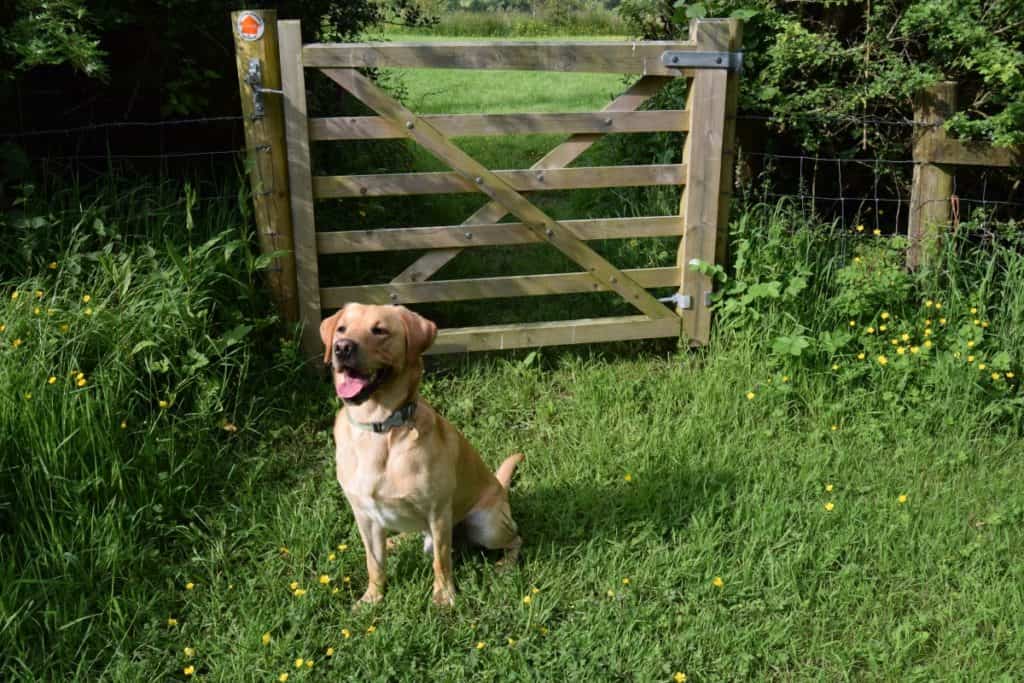
When things go wrong
So, what can happen if you haven’t adequately socialised your dog in a particular area?
One Summer evening I took Harvey for one of our regular walks. When I say regular we had probably done it hundreds of times.
Walk to the end of our road, cross a fairly busy main road, down a short country lane, and then the walk is around the perimeter of a large field. Harvey is allowed to walk off-lead in this field.
At the far end of the field, at the furthest distance from the field entrance, is a small wooded area.
As we approached, with Harvey about 10 yards ahead, a lad on a bike rode out and was heading straight for Harvey.
Harvey took off at high speed and flew straight by me! Our normally flawless recall had no impact.
Do you know what? Dogs are damn quick!!! I got to the end of the lane and still couldn’t see him. Time to do an ET and phone home …
- Me: Pant. Pant. Harvey. Pant. Has. Pant. Run. Pant. Off.
- OH: He’s here.
- Me: Pant. What? Pant.
- OH: There was a knock at the door. When I answered it was Harvey!
- Me: Pant. Sigh. Pant.
- OH: Have you been running?
Now, I had ‘done’ bikes as part of Harvey’s puppy socialisation process. But not bikes coming out of concealment and heading straight for him!
I’m telling you this just to illustrate how things which seem pretty innocuous to us can appear anything but to our dogs.
This is why we socialise them.
We aim to give our dogs sufficient confidence that events like the one above are a rarity (we’ve not had anything similar happen in the following 5 years).
Puppy parties
One of the best ways of socialising your puppy is to go to well-organised puppy parties or puppy classes.
These are often organised by veterinary practices and local dog trainers. You may also find local groups on social media or by word of mouth.
These parties provide great opportunities for the multiple items socialising mentioned above.
You’ll often find:
- People of different ages, gender, size, ethnicity
- Wearing a variety of different clothing
- Carrying a variety of objects with them
- A variety of different puppies and possibly adult dogs too
- It’ll be at a new location
- You’ll probably travel by car to get there
- There may be different surfaces and textures around
Most of these parties are well run and very beneficial for your puppy’s socialisation. However, some are not well run, either through inexperience or lack of understanding.
Remember, you want all of your puppy’s socialisation experiences to be happy ones. If you see that your puppy is struggling, or you don’t feel comfortable with the situations that he is being placed in, then leave.
Sounds good to me
There are a great many different noises that your puppy needs to become familiar with.
One of the most important of these is fireworks. Dogs can suffer from fireworks-induced stress if they are not used to the sound of fireworks.
You can address many of the sound experiences in the comfort of your own home (which makes the training much simpler) by acquiring a CD or mp3 download of common socialisation sounds.
For example, you can find some produced by the Dog’s Trust here.
6 The Puppy Socialisation Plan Checklist
Please use the link below to join the Richie’s Room email subscriber list and download your free copy of the Puppy Socialisation Plan checklist.
- Click this link: Puppy Socialisation Plan
- Enter your email address and click the Subscribe button
- Check your inbox for an email and click the pdf download link
- Save or print your Puppy Socialisation Plan
Try to complete as many things as you can.
For each experience, you should make an assessment as to whether your puppy was:
- Happy / confident
- Neutral
- Unhappy / scared
What we want is one or more happy encounters and this is what you should try to engineer. Don’t push your puppy if he appears unsure – let him move forward at his own pace.
If you have a neutral or unhappy encounter then it’s time for some evaluation. What went wrong?
Keep in mind that if something did go wrong it will, without exception, be something that you did – not something your puppy did.
We all make mistakes. Don’t beat yourself up about it – learn from it and decide how to do it better next time.
If the opportunity is still available, and you have identified what went wrong the first time, then, by all means, try again. Imprinting a positive experience over the top of the initial negative one will be very valuable.
However, don’t do too much in any one session. Your puppy can tire quickly at this age.
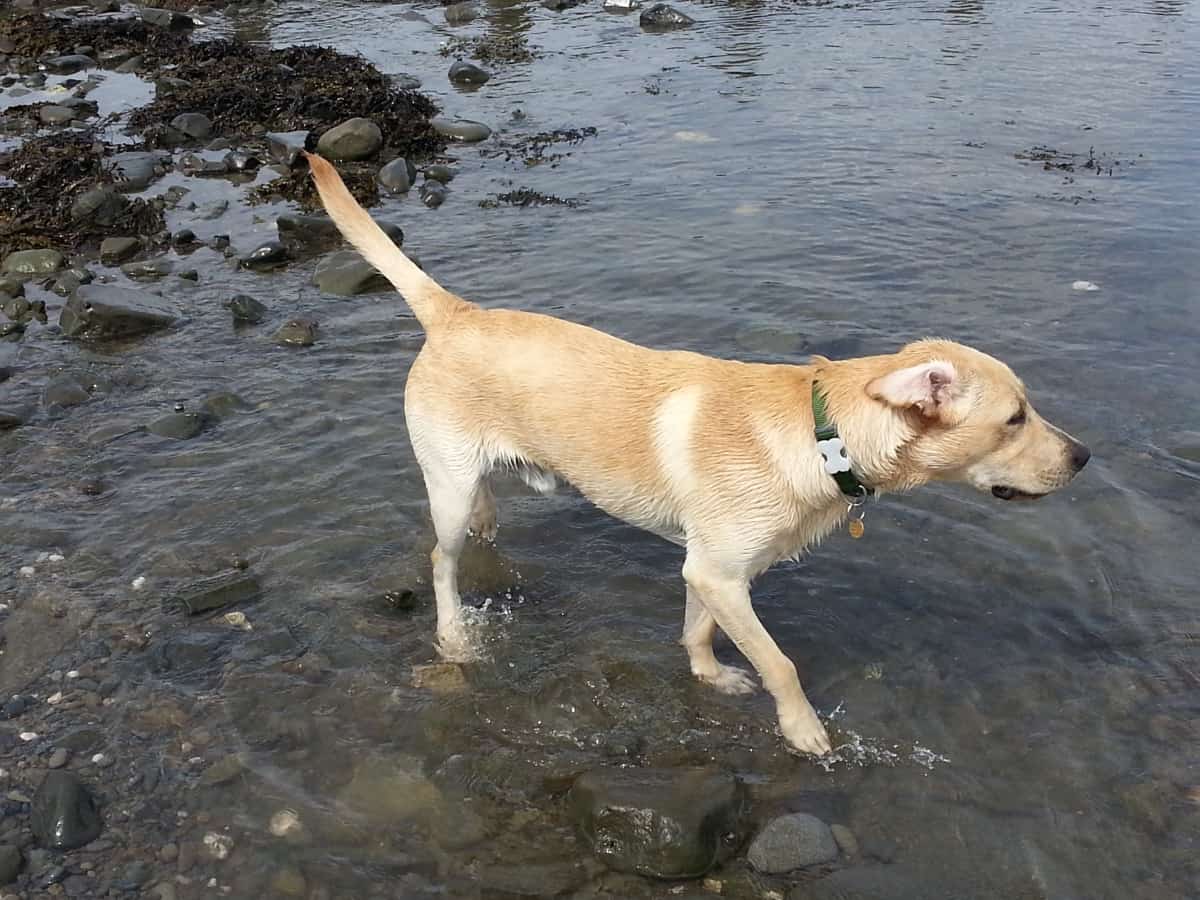
7 Thoughts and Observations – the Benefits of Hindsight
There are a lot of things to consider when you are socialising a puppy for the first time.
But for those that have been through the process before are there any things that they would do differently the next time?
I posed this question on the My Labrador Friends forum and below is a combination of my own thoughts and some of those from the forum.
Enough … but not too much
It is hugely important that your puppy is well socialised with other dogs. However…
This does not mean that you should try to have your puppy meet every dog that you encounter while out and about.
If you do then you can create a situation where your dog expects to meet every dog you encounter whenever you go out.
This can be a problem because it can be quite stressful for some dogs. Or, perhaps he just becomes hugely excited and becomes difficult to handle.
And it can be plain inconvenient for you too – you want to walk but your dog has other ideas!
An important skill to develop during your socialisation with other dogs is … not meeting other dogs. That is:
Take control
If your puppy is being too rough when playing (or if his companion is) then don’t be afraid to remove him from the situation and let him calm down for a while.
You don’t want your puppy to grow up thinking that this is acceptable behaviour with other dogs.
And believe me – it’s considerably easier to intervene between two over-excited puppies than it is between two such dogs.
Give control
Conversely, sometimes you need to give control of the situation to your puppy.
Imagine if you are carrying your young puppy and somebody asks if they can ‘say hello’.
This is a good thing as we want our puppy to meet a wide range of people.
However, while in your arms your puppy has no means of escape if it feels uncomfortable with the attention being received.
Ideally, your puppy should be on the ground so that he can withdraw from the situation if he isn’t happy.
If this isn’t possible (for example, pre-vaccination in an unsuitable area) then you need to monitor the situation carefully and ‘rescue’ your puppy if he begins to look as if he has had enough.
Assess your puppy’s temperament
Just as with humans, no two puppies are the same.
Genetics will play a part in how your puppy develops.
Some breeds have different inherent characteristics to others. But even within a particular breed, there will be considerable variation between dogs.
This is why organisations that rely heavily on dogs, like Guide Dogs for the Blind, place great emphasis on their breeding programmes as well as the socialisation and training that they undertake.
So, try to establish what your puppy is comfortable doing and, equally as important, what he is not comfortable doing.
Watch for signs of fear in more timid dogs and for building frustration in more sociable dogs.
There is a well-used saying in the dog-training world: “Train the dog in front of you.“
Don’t encourage jumping-up
It’s cute when your puppy jumps up on you or other people, isn’t it?
Not so much when your fully grown dog puts his front paws on a frail elderly person, or small child, and knocks them over!
Some people, for whatever reason, are very anti-dog. Don’t give them an excuse to make a formal complaint that could turn out badly for you or your dog.
When socialising your puppy with people ask them not to encourage any jumping-up behaviour – but heavily praise and reward keeping all four paws on the ground.
Use the ‘off’ switch
In a similar manner to the ‘don’t greet every dog’ point above, don’t always have human encounters where the puppy is the centre of attention.
If every human encounter is ‘playtime’ as far as the puppy is concerned then he will grow up expecting this to always be the case.
That is, he will crave constant attention. And, therefore, potentially be a nuisance whenever you have visitors or when you go out.
So, sometimes, after initial greetings, encourage visitors not to engage with your puppy for a while.
This will help him to realise that not every human encounter is a non-stop play session. That is, it will help him to develop an ‘off’ switch.
8 Frequently Asked Questions
What is Puppy Socialisation?
Socialisation means exposing your puppy to different experiences now so that as an adult dog he will know how to act appropriately when facing those same experiences.
At what age should a puppy be socialised?
The critical period is from 3 to 14 weeks. Whilst socialisation continues after this period it is not at the same intensity. Put the effort in now and reap the benefits later.
What is the best approach to puppy socialisation?
Have a plan! Don’t just meander through puppyhood hoping that things will work out – take the initiative and schedule the things that you need to do.
Can you do too much puppy socialisation?
It’s unlikely. Of course, we should let our puppies move at a pace that they are comfortable with but they are incredibly resilient at this age and it is vital that we adequately socialise them.
Can a puppy be socialised before it is fully vaccinated?
Absolutely. You should take sensible precautions, of course, but you should start the socialisation process as soon as possible. If in doubt, speak with your vet.
9 Infographic
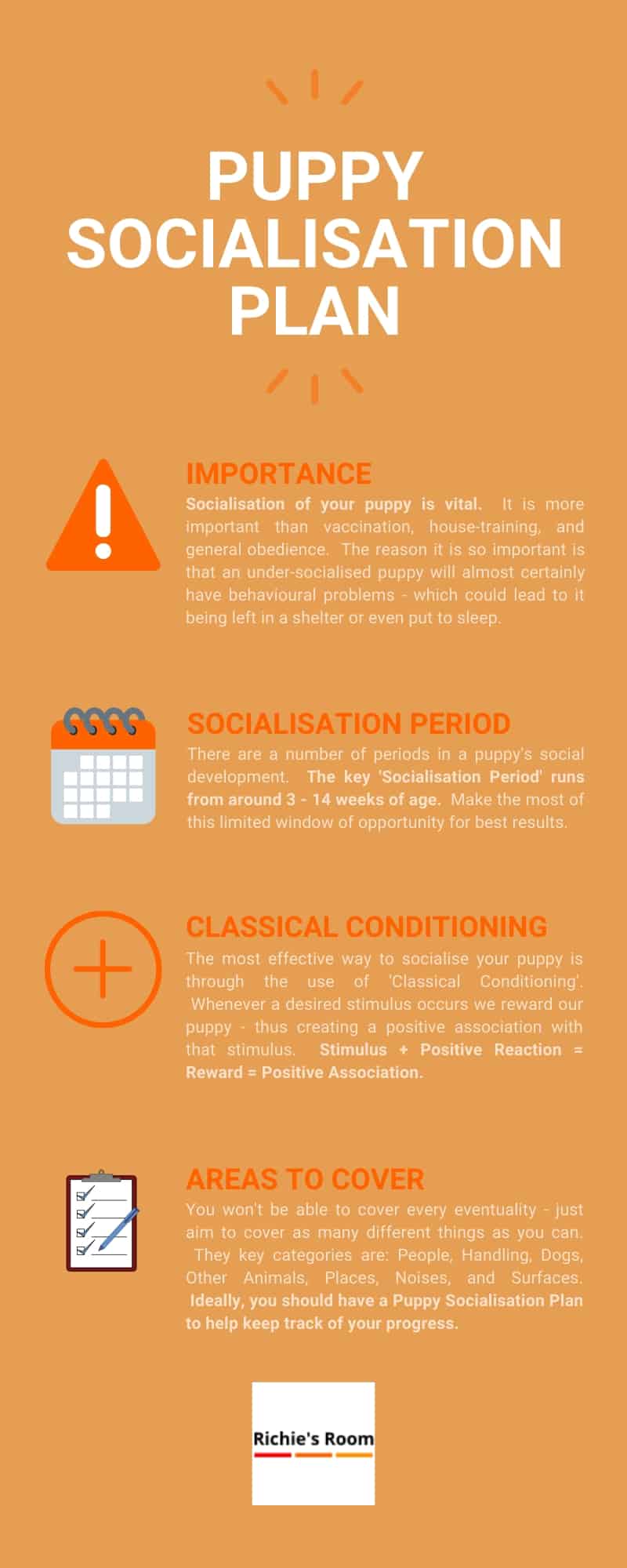
10 Acknowledgements
Image acknowledgements:
And
11 The End
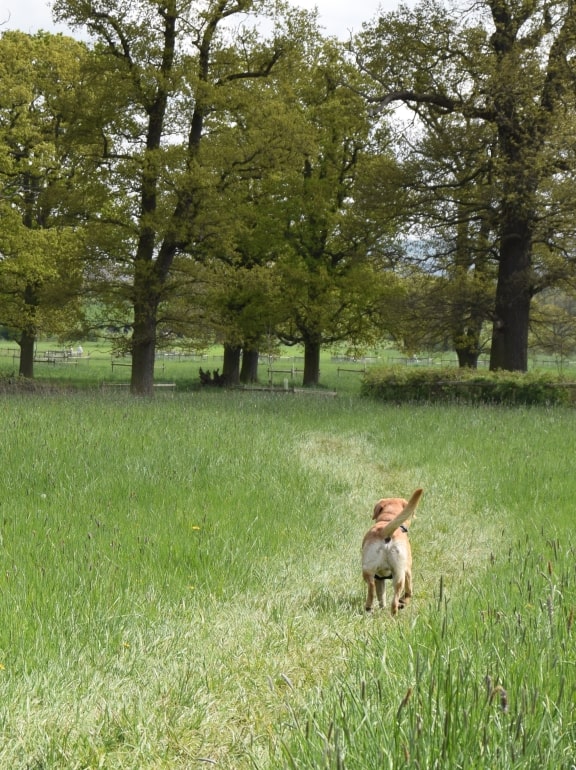
I hope that you’ve enjoyed this post.
Feel free to navigate around the site to see if there is anything else that may be of interest to you.
If you liked this post please share it. Thank you 🙂
If you’d like a heads-up when the next post is issued sign-up to the Richie’s Room Newsletter.
And, if you’d like to add a comment that would be great too – you can do that below.

Awesome post! I tried to socialize my puppy as much as possible because it’s super important. She’s three now and I still teach her commands with no problem
Thanks, Alexis, much appreciated.
These are great tips! Our dog is almost 8 and very timid in general. She gets spooked by other dogs. Maybe we could have done more to socialize her as a puppy. We think she was abandoned before we rescued her. So maybe she has a lot of insecurities.
Thanks, Jen. It’s always hard to know what experiences a rescue dog may have had – all you can do is know that you’ve done a good thing by making their situation better going forward. Good for you 🙂
This is a really helpful post, thank you for sharing your tips and advice.
Lauren
Hey Lauren, glad you found it useful.
Richie – great article, lots of information. Loved the personalization with pics of your dogs. Especially loved the infographic. Our dog, Hairy Kerry, was a freak show when he was a puppy. We socialized him by taking him to puppy daycare a few days each week. He loves it! I hate spending the money. Lol
Hey PS. Thanks very much – I’m glad that you loved it.
This is such a helpful and informational post!!! My boyfriend and I are thinking about a puppy and this post could not have came at a better time! Thank you so much for this thoughtful advice + Thank you extra for adding such AMAZING pictures!
Hi Pam. Glad that you found it helpful. Good luck with the puppy!
These are really great tips and some of them I wish I’d known about when I first got a puppy.
Hi Kelly. Thank you. Yes, hindsight is a wonderful thing, isn’t it?
Thanks so much for sharing all these tips! I’m looking at getting a puppy, so I’ll definitely be saving this post for if I do! I’m sure many people will find this super helpful too!
Hey Charley. Glad you enjoyed the post. And good luck with the puppy.
What a great article. So many ideas that I did not do when I got my dog. I will pass this along for sure.
Hi Elaine. Thank you, that’s very kind of you.
A really great post – very informative! Good info for people getting puppies 🙂
Thank you, Ellie. Glad that you enjoyed it.
Great post! Really detailed and interesting. Great pics too!
Thanks, Graham, glad that you enjoyed it.
When we got a dog way back in the 80s, the puppy already had shyness problems when we got her from the shelter. She pretty much remained a scared dog, would disappear to the other end of the house if someone new entered, and throw themselves as the door if someone rang or tried to post letters. So yeah, socialising your puppy could have it’s advantages to your dog’s behaviour
Hi, thanks for your feedback. It’s so much easier to deal with during the socialisation period. You can still address it later, but it’s more difficult.
I just love all the dog photos 😃😂 very informative and helpful post too.
Adam
Hi Adam. Thank you for your feedback (I try to include photos when I can as I think they help to break-up the text for the reader)
I never before realised the importance of puppy socialisation, but after reading all that you’ve explained here, it makes sense that a fearless puppy should meet stimuli and learn from every positive experience.
Thanks for sharing this article with me.
Hi, Matthew. I’m glad that you enjoyed it.
You make some great points. Early socialization is SO important to prevent problems down the road, we just have to be smart about it. Rather than bringing your puppy around unknown dogs prior to their vaccinations being complete, set up ‘puppy play dates’ with a friend’s dog. That way you know that your dog is safe. That also allows you to connect with another dog whose owner is going to be alert, reacting if necessary to keep everyone safe. Unfortunately, the same can’t always be said for public situations like at dog parks or meeting a dog on a walk.
Hi Britt. Thanks for your comment. You are absolutely right, organised ‘puppy parties’ are a far better option than random meetings at a dog park.
This is such an awesome post with great tips! With all the dogs I’ve had growing up I have never even thought about how important socialization is for puppies/dogs and not just a skill for children to learn.
I like how u mention that it should be the first priority and not the last,which I agree with.
Thanks so much for sharing.
Thanks for your feedback, Rebekah. Historically I don’t think that socialisation has been something that many (any?) dog owners have given much thought to. However, just as dog training practices have moved forward so have developments in other areas. These days, now that we know more, I think socialisation is vital.
I learned so much reading this post, Richie! I wish I had read this when my dog was still a puppy, but she’s now more than 10 years old – and she is scared of the rain & thunder as well as fireworks. When I do get a new puppy, I’ll definitely make sure to have a socialisation plan in place. And it would be so fun to experience a puppy party too one time!
Hi Izzy. I’m glad that you found the post to be informative. What’s your dog’s name? You can still help her to cope better with things like fireworks – have you seen this post on fireworks?
My dog’s name is Ruby. When it rains, I usually pat her & play meditation music to calm her down :)) Ohh thank you for linking me to that post – I’ll definitely check it out 🙂
Hi Izzy. Yes, do take a look – with fireworks, as with many things in life, some advance preparation goes a long way. I hope it helps.
A super interesting and informative post, its made me much more aware now of the things you should do!
Amber | The Unpredicted Page
Thanks, Amber, glad that you liked it.
This is such good information for those getting puppies. Quite a lot of my friends and family have puppies at the moment, although sadly not myself yet, so I’ll pass on the information I’ve learnt to them!
Hey Alex. Thank you. I hope that the information is helpful to your friends and family.
It is so important that dogs learn to be social. I found that dogs who keep barking at other dogs might have social issues that were never ironed out. I like that you give tips on getting pups socialized. I don’t have a dog but found this relatable with cats. Thanks for sharing!
Nancy ✨
Hello Nancy. Many thanks for your comment – much appreciated.
This is such a detailed post! It’s so important to make sure that your puppy understands what it’s like being around other dogs and how to interact well, so it’s so great to have a guide like this.
Thanks, Jupiter, for taking the time to provide a comment. Much appreciated.
Wow, what a truly detailed post Richie and some fantastic advice on socialiszing a puppy. I really enjoyed reading this!
Hi Luke. I’m glad that you enjoyed it – thanks for the comment.
Reading this is so useful — I don’t currently have a dog but if/when I do I now have a reference point. Thanks!
Thank you, Molly. I’m glad that you found it to be useful. And good luck for when you get a dog 🙂
Wow, this was such a comprehensive post, Richie. I’m not a dog owner (nor am I likely to be) but a lot of what you say is also applicable to cats. One of ours was semi-feral and didn’t have the socialisation he was supposed to receive when he was a kitten. He’s still quite jumpy now but much better than he was. This is something that any pet owner needs to take responsibility for with any young animal, I think. Great tips, thank you!
Hi Lisa. Thanks for your comment. Yes, I don’t doubt that there are similar considerations for cats. I still have a soft spot for cats – so does Harvey but the cats rarely hang around long enough to let him show this!
Thanks for giving these tips, my dog seems to afraid of everything, hope it works on him.
Thanks for your feedback, Bob. Good luck with your dog’s socialisation.